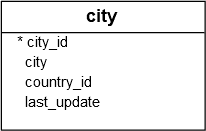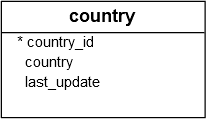Summary: in this tutorial, you will learn how to use the PostgreSQL NATURAL JOIN to query data from two tables.
Introduction to PostgreSQL NATURAL JOIN clause
A natural join is a join that creates an implicit join based on the same column names in the joined tables.
The following shows the syntax of the PostgreSQL NATURAL JOIN clause:
SELECT select_list
FROM table1
NATURAL [INNER, LEFT, RIGHT] JOIN table2;In this syntax:
- First, specify columns from the tables from which you want to retrieve data in the
select_listin theSELECTclause. - Second, provide the main table (
table1) from which you want to retrieve data. - Third, specify the table (
table2) that you want to join with the main table, in theNATURAL JOINclause.
A natural join can be an inner join, left join, or right join. If you do not specify an explicit join, PostgreSQL will use the INNER JOIN by default.
The convenience of the NATURAL JOIN is that it does not require you to specify the condition in the join clause because it uses an implicit condition based on the equality of the common columns.
The equivalent of the NATURAL JOIN clause will be like this:
SELECT select_list
FROM table1
[INNER, LEFT, RIGHT] JOIN table2
ON table1.column_name = table2.column_name;Inner Join
The following statements are equivalent:
SELECT select_list
FROM table1
NATURAL INNER JOIN table2;And
SELECT select_list
FROM table1
INNER JOIN table2 USING (column_name);Left Join
The following statements are equivalent:
SELECT select_list
FROM table1
NATURAL LEFT JOIN table2;And
SELECT select_list
FROM table1
LEFT JOIN table2 USING (column_name);Right join
The following statements are equivalent:
SELECT select_list
FROM table1
NATURAL RIGHT JOIN table2;And
SELECT select_list
FROM table1
RIGHT JOIN table2 USING (column_name);Setting up sample tables
The following statements create categories and products tables, and insert sample data for the demonstration:
CREATE TABLE categories (
category_id SERIAL PRIMARY KEY,
category_name VARCHAR (255) NOT NULL
);
CREATE TABLE products (
product_id serial PRIMARY KEY,
product_name VARCHAR (255) NOT NULL,
category_id INT NOT NULL,
FOREIGN KEY (category_id) REFERENCES categories (category_id)
);
INSERT INTO categories (category_name)
VALUES
('Smartphone'),
('Laptop'),
('Tablet'),
('VR')
RETURNING *;
INSERT INTO products (product_name, category_id)
VALUES
('iPhone', 1),
('Samsung Galaxy', 1),
('HP Elite', 2),
('Lenovo Thinkpad', 2),
('iPad', 3),
('Kindle Fire', 3)
RETURNING *;The products table has the following data:
product_id | product_name | category_id
------------+-----------------+-------------
1 | iPhone | 1
2 | Samsung Galaxy | 1
3 | HP Elite | 2
4 | Lenovo Thinkpad | 2
5 | iPad | 3
6 | Kindle Fire | 3
(6 rows)The categories table has the following data:
category_id | category_name
-------------+---------------
1 | Smartphone
2 | Laptop
3 | Tablet
4 | VR
(4 rows)PostgreSQL NATURAL JOIN examples
Let’s explore some examples of using the NATURAL JOIN statement.
1) Basic PostgreSQL NATURAL JOIN example
The following statement uses the NATURAL JOIN clause to join the products table with the categories table:
SELECT *
FROM products
NATURAL JOIN categories;This statement performs an inner join using the category_id column.
Output:
category_id | product_id | product_name | category_name
-------------+------------+-----------------+---------------
1 | 1 | iPhone | Smartphone
1 | 2 | Samsung Galaxy | Smartphone
2 | 3 | HP Elite | Laptop
2 | 4 | Lenovo Thinkpad | Laptop
3 | 5 | iPad | Tablet
3 | 6 | Kindle Fire | Tablet
(6 rows)The statement is equivalent to the following statement that uses the INNER JOIN clause:
SELECT *
FROM products
INNER JOIN categories USING (category_id);2) Using PostgreSQL NATURAL JOIN to perform a LEFT JOIN
The following example uses the NATURAL JOIN clause to perform a LEFT JOIN without specifying the matching column:
SELECT *
FROM categories
NATURAL LEFT JOIN products;Output:
category_id | category_name | product_id | product_name
-------------+---------------+------------+-----------------
1 | Smartphone | 1 | iPhone
1 | Smartphone | 2 | Samsung Galaxy
2 | Laptop | 3 | HP Elite
2 | Laptop | 4 | Lenovo Thinkpad
3 | Tablet | 5 | iPad
3 | Tablet | 6 | Kindle Fire
4 | VR | null | null
(7 rows)3) Example of using NATURAL JOIN that causes an unexpected result
In practice, you should avoid using the NATURAL JOIN whenever possible because sometimes it may cause an unexpected result.
Consider the following city and country tables from the sample database:

 Both tables have the same
Both tables have the same country_id column so you can use the NATURAL JOIN to join these tables as follows:
SELECT *
FROM city
NATURAL JOIN country;The query returns an empty result set.
The reason is that both tables have another common column called last_update. When the NATURAL JOIN clause uses the last_update column, it does not find any matches.
Summary
- Use the PostgreSQL
NATURAL JOINclause to query data from two or more tables that have common columns.